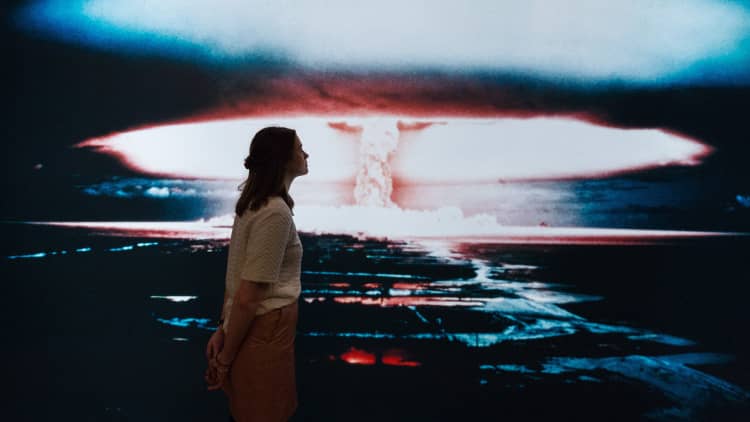North Korea announced on Sunday that it had successfully conducted its sixth and most powerful nuclear test, using what it said was an advanced hydrogen bomb — or an "H-bomb".
Experts haven't yet verified whether the weapon was indeed an "H-bomb", though they widely agree that it created an explosion which far exceeded previous tests. U.S. Geological Survey measured the explosion at a magnitude of 6.3, and shockwaves were measured at more than 130 stations in destinations as far away as Argentina.
But what exactly is an H-Bomb? CNBC explains…
What is a hydrogen bomb?
A hydrogen bomb is a type of nuclear bomb, just like an atomic bomb, where the explosive energy comes from as nuclear reaction. The difference comes from how that energy is created.
An atomic bomb uses fission, that is, the breaking of an atom's nucleus into smaller particles. This results in the release of neutrons and lots of energy that become an atomic explosion. In comparison, a hydrogen bomb is about fusion — fusing atomic nuclei together to combine into bigger ones.

A hydrogen bomb, or a thermonuclear bomb, contains a fission weapon within it but there is a two-stage reaction process.
It uses the energy from a primary nuclear fission to set off a subsequent fusion reaction. The energy released by fusion is three to four times greater than the energy released by fission, giving the "hydrogen" bomb, or H-bomb, more power. The name comes from the fact that it uses a fusion of tritium and deuterium, hydrogen isotopes.
Essentially, an H-bomb is only limited by the amount of hydrogen within it and can be made as powerful as its builder wishes it to be, making it a big threat should a perceived "rogue" state like North Korea develop one.
When was it created?
The U.S. used two atomic bombs in World War II against Japan, effectively forcing the country to surrender and ending the war. Then, in 1952 and 1954, it detonated hydrogen bombs in the Marshall Islands.
In 1954, the U.S. conducted further tests of the hydrogen bomb in the Bikini Atoll in the Marshall Islands. One of the bombs detonated as part of a series of tests was called "Castle Bravo." It produced an explosion believed to be up to 1,000 times more powerful that the atomic bomb that destroyed Hiroshima.
The Bravo bomb yielded 15 megatons (15 million tons of TNT) and was - and is still - the largest bomb ever exploded by the U.S., Atomic Heritage notes. The largest ever hydrogen bomb, known as the "Tsar Bomba," was detonated by the then-Soviet Union in 1961, with a yield of 50 megatons.
How might it be used?
The world was first alerted to North Korea's hydrogen bomb developments in January 2016, when it claimed to have created a "miniaturized" H-Bomb.
The announcement caught the attention of world leaders and nuclear experts far more than its previous nuclear bomb tests because it indicated that North Korea may have developed the capability of creating an "H-bomb" on a much smaller scale than those previously seen.
This means a bomb that could potentially fit on the end of a missile and be launched by a submarine or aircraft.
North Korean state media published photos Sunday of President Kim Jong Un inspecting a peanut-shaped device in front of a diagram, which led analysts to suspect it could be fitted into the nose cone of an intercontinental ballistic missile (ICBM).
In a statement Sunday, the North Korean agency responsible for developing nuclear weapons described the manufacturing of an "H-bomb to be placed at the payload of the ICBM."
Should we be scared?
It is still unclear whether the weapon tested by North Korea was a hydrogen bomb but experts have begun analysis, using sniffer stations around the world that can detect radioactive pollution released by nuclear explosions.
In particular, monitors will be looking for isotopes of a gas called xenon, which is typically present in H-bomb reactions.
Analysis from Norsar, a Norweigan geoscience research foundation, suggests that the explosion created by Sunday's test is far greater than that seen in North Korea's last alleged H-Bomb test, which took place in September 2016.
It estimates the explosive yield of the recently tested bomb to be at 120 kilotrons TNT. This compares to about 20 kilotrons TNT this time last year.
"North Korea claims that this was a test of a hydrogen bomb; the same claim was made for previous tests," Norsar said. "It is not possible from the seismic data alone to determine if this was a test of a hydrogen bomb, but we can say in general that the credibility of the claim increases with increasing explosive yield."
Analysts suggest, however, that the tests could be an attempt by the North Korean President to uphold his regime and prevent interference by external leaders, rather than spark a mass conflict.
"The risk of a full blown war in the Korean peninsula has risen. However, we still think that the North will not intentionally start a war," Anwita Basu, North Korea analyst at the Economist Intelligence Unit, said in a press note Monday.
"This will be a zero sum game for them. They are in fact simply taking advantage of the fact that Donald Trump is erratic and there is little prospect of a unified international front that can contain the North's military aspirations for now."



